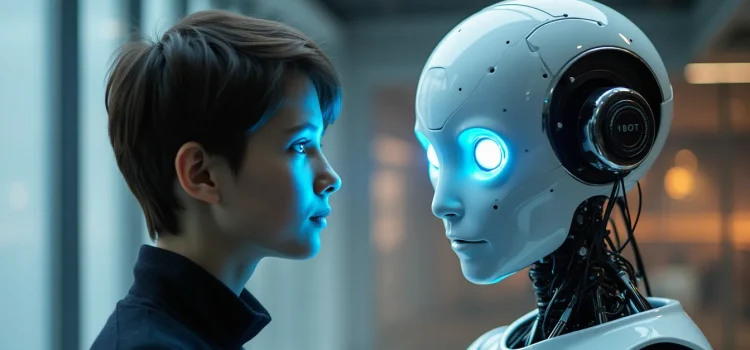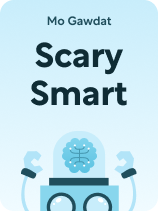

This article is an excerpt from the Shortform book guide to "Scary Smart" by Mo Gawdat. Shortform has the world's best summaries and analyses of books you should be reading.
Like this article? Sign up for a free trial here.
Is AI smarter than humans, or will it be at some point? How will artificial intelligence compare to human brainpower in the coming years?
In Scary Smart, Mo Gawdat explores the rapid advancement of AI and its potential to surpass human intelligence. He delves into the concepts of artificial general intelligence and quantum computing, painting a picture of a world where machines think faster and more efficiently than we do.
Keep reading to learn about the prospects of artificial intelligence.
Artificial Intelligence vs. Human Intelligence
Throughout his book, Gawdat refers to artificial intelligence as “scary smart.” To understand why, we’ll start by examining what makes artificial intelligence—which broadly refers to machines that can mimic aspects of human thinking, learning, and intelligence—so smart.
Is AI smarter than humans? Gawdat explains that he and other experts expect future forms of AI to have superhuman levels of intelligence.
(Shortform note: What is AI, exactly? Experts say there isn’t just one definition, though many think that’s good because it gives the field room to evolve. That said, you can think of AI—which enables computers to think like humans and do things that require “intelligence”—as existing on a spectrum. Consider the software that enables you to talk to Siri on your iPhone or the model that can beat world champions at the complex game Go. These forms of AI differ widely in the scale of the tasks they complete, their autonomy, and the broadness or narrowness of their skills. All AI models differ along these dimensions, making what they can do look more or less like human intelligence.)
Artificial intelligence might not think exactly like humans do, but that won’t keep it from matching or surpassing us in many skills. Gawdat predicts that machines will become more intelligent than humans in the near future, perhaps as soon as 2029. We’re accustomed to being the most intelligent species on Earth, but Gawdat points out that human intelligence has some significant limitations. As individuals, we have limited memory, imperfect recall, poor multitasking skills, and finite cognitive capacity. Plus, we’re inefficient at sharing knowledge.
Computers aren’t limited in these ways. They can have vast amounts of memory and perfect recall. They also share information almost instantaneously. Machines can also have enormous amounts of processing power, which enables them to “think” a lot more quickly than we do: AI already makes billions of decisions every second to do things like serving personalized ads on Facebook and making content recommendations on Netflix. Humans simply can’t think that fast.
| Does Artificial Intelligence Work Like Human Intelligence? Human intelligence has its limits, as Gawdat points out, but modern AI still takes its cues from the human brain. Since the 1950s, researchers have built “artificial neural networks,” mathematical systems loosely inspired by the brain’s method of passing signals from neuron to neuron. Modern AI tools, like the large language model GPT and the image generator Midjourney, rely on layers of synthetic “neurons,” or “nodes.” Each is an equation that sends its output to the next neuron. The human brain has 100 million neurons and 600 trillion connections among them, so a model that even loosely mimics it requires enormous amounts of data and energy. Neural networks have thousands or millions of densely interconnected nodes. The nodes are arranged in layers, and information moves in one direction through them. When one node receives data from another, it has to decide whether to pass that information along. It does that by evaluating the “weight,” or the strength of its connection, with the other node. (In the human brain, this is like a signal encountering a synapse: a space between two neurons that it can’t cross without help.) If the weight is strong enough, the node passes the signal on, contributing to the neural network’s final output. As the neural network learns, it adjusts each weight to produce the correct answer to your question. While early versions of artificial neural networks didn’t really work like the human brain, neuroscientist Jean-Rémi King contends that “neural network” is no longer just a metaphor for how this kind of AI processes information. King and other experts assert that these models might even help us study how our brains do things like process language. The idea that AI can give us valuable predictions or models for how the brain works is controversial because these systems don’t have the biological constraints of the human brain. But many experts think AI is a powerful tool for exploring (if not explaining) how the brain works—as long as we’re careful about interpreting the results. |
Gawdat explains that computers will soon be more intelligent than we are thanks to two intertwined advances: artificial general intelligence and quantum computing. We’ll explore each of these next.
Artificial General Intelligence
While the AI systems we have now are smart, they’re good at processing just one kind of information or helping us with a specific type of task. Gawdat explains that the specialized forms of AI we have now will give way to what experts call “artificial general intelligence” (AGI). While current forms of AI are trained to master a single skill, AGI would be much less limited, much more versatile, and much more like human intelligence.
To think about how this works, consider ChatGPT. ChatGPT is a chatbot based on GPT, a large language model that generates text by predicting what word is most likely to come next. ChatGPT is good at just one task: generating text. But it’s so good at that task that many people enjoy having conversations with ChatGPT—or at least trust it enough to give it tasks like writing academic papers or legal briefs. Gawdat explains that instead of having just one kind of intelligence like ChatGPT, future forms of AI will have and be much more than that: They’ll be able to learn and gain knowledge across different areas. That means they’ll excel at not just a single task but at a whole array of tasks.
Quantum Computing
Gawdat predicts that progress toward artificial general intelligence will be sped up by a technology called quantum computing. Quantum computers take advantage of quantum mechanics, the theory that predicts strange behaviors of matter and energy at the atomic level. At this level, particles can blink in and out of existence, occupy more than one position at the same time, and exist in multiple states simultaneously. Quantum computers use these counterintuitive phenomena to process information differently from classical computers.
Classical computers represent information with “bits.” Each bit contains a one or a zero. String enough ones and zeroes together, and you have code that represents a letter, a number, or any other piece of information. Quantum computers process data in “quantum bits” or “qubits.” Because of a phenomenon called superposition, where a particle can exist in two different states at the same time, each quantum bit can contain both a one and a zero simultaneously. Each quantum bit contains twice as much information as a traditional bit, enabling the computer to consider more information at a time without more processing power.
Gawdat explains that quantum computers can solve much more complex problems than classical computers can handle—like the problem of creating AI that matches or surpasses human intelligence. He contends that quantum computing will make it possible for AI to become much smarter than we are: billions of times smarter, in his estimation.

———End of Preview———
Like what you just read? Read the rest of the world's best book summary and analysis of Mo Gawdat's "Scary Smart" at Shortform.
Here's what you'll find in our full Scary Smart summary:
- Why we can’t control or contain artificial intelligence
- The most efficient way to change what AI learns to do
- How to keep AI from taking us down a path toward dystopia






